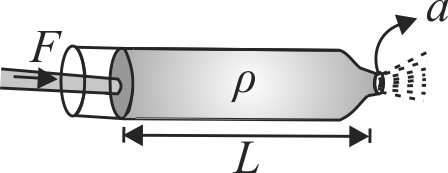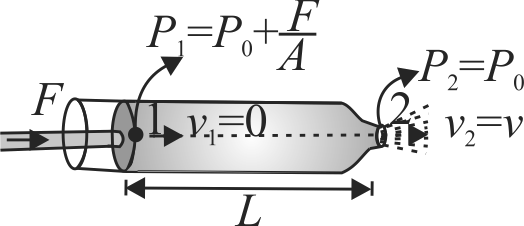360861
Calculate work should be done (in \(J\) ) in order to squeeze all water from a horizontally located cylinder as shown in figure during the time \(t=10 {~s}\) by means of a container force acting on the piston? The volume of water in the cylinder is equal to \(V=1\) lit, the cross-sectional area of the orifice is \(a=0.5 {~cm}^{2}\), with a being considerably less than the pistol area. The friction and viscosity are negligibly small.
360864 There is a hole of area \(\frac{1}{{25}}\;c{m^2}\) in the bottom of a cylindrical vessel containing fluid up to height \(h\). The liquid flows out in time \(t\). If the liquid were filled in the vessel up to height \(4 h\), then it would flow out in time
360861
Calculate work should be done (in \(J\) ) in order to squeeze all water from a horizontally located cylinder as shown in figure during the time \(t=10 {~s}\) by means of a container force acting on the piston? The volume of water in the cylinder is equal to \(V=1\) lit, the cross-sectional area of the orifice is \(a=0.5 {~cm}^{2}\), with a being considerably less than the pistol area. The friction and viscosity are negligibly small.
360864 There is a hole of area \(\frac{1}{{25}}\;c{m^2}\) in the bottom of a cylindrical vessel containing fluid up to height \(h\). The liquid flows out in time \(t\). If the liquid were filled in the vessel up to height \(4 h\), then it would flow out in time
360861
Calculate work should be done (in \(J\) ) in order to squeeze all water from a horizontally located cylinder as shown in figure during the time \(t=10 {~s}\) by means of a container force acting on the piston? The volume of water in the cylinder is equal to \(V=1\) lit, the cross-sectional area of the orifice is \(a=0.5 {~cm}^{2}\), with a being considerably less than the pistol area. The friction and viscosity are negligibly small.
360864 There is a hole of area \(\frac{1}{{25}}\;c{m^2}\) in the bottom of a cylindrical vessel containing fluid up to height \(h\). The liquid flows out in time \(t\). If the liquid were filled in the vessel up to height \(4 h\), then it would flow out in time
360861
Calculate work should be done (in \(J\) ) in order to squeeze all water from a horizontally located cylinder as shown in figure during the time \(t=10 {~s}\) by means of a container force acting on the piston? The volume of water in the cylinder is equal to \(V=1\) lit, the cross-sectional area of the orifice is \(a=0.5 {~cm}^{2}\), with a being considerably less than the pistol area. The friction and viscosity are negligibly small.
360864 There is a hole of area \(\frac{1}{{25}}\;c{m^2}\) in the bottom of a cylindrical vessel containing fluid up to height \(h\). The liquid flows out in time \(t\). If the liquid were filled in the vessel up to height \(4 h\), then it would flow out in time

